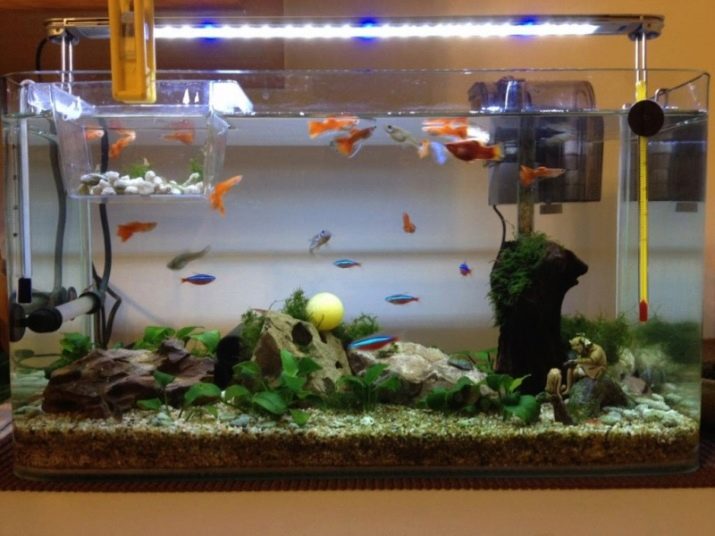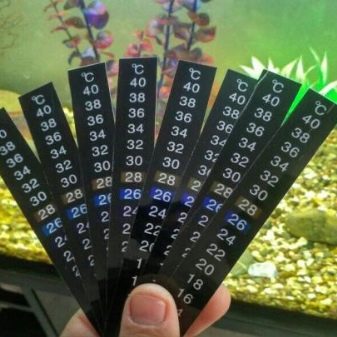What should be the water temperature for guppies in the aquarium and how to maintain it?

Guppies are one of the most popular fish among both novice aquarists and experienced professionals. Because of their ease of care, these fish are great for children. For comfortable keeping and breeding, it is important to know and follow simple rules. It must be borne in mind that the natural range of guppies is the northeastern part of the South American continent. Although the fish of this breed are considered the most unassuming of living conditions in the aquarium, it is important for them to maintain an acceptable water temperature. If it does not suit the residents of an artificial reservoir, then they will start to get sick and die.

Effect of temperature on fish
Whatever pets live in the aquarium, unexpected and sudden changes in temperature (more than 3 C) will negatively affect them. Residents of a home reservoir are equally badly affected by both too high and too low water temperatures. If it changes smoothly over a long time, then it is quite possible that the fish will tolerate this normally.
But if changes occur rapidly (within an hour by 2 or more degrees), then the consequences can be very sad. This sometimes happens, especially small reservoirs with a volume of less than 50 liters, not equipped with heaters, are especially susceptible to temperature fluctuations. In such tanks, the liquid cools down very quickly. Even a window that is slightly open for airing in winter can cool the aquarium.


Another reason that can affect the comfortable environment in the tank is the use of unheated water for a partial change. From hypothermia, the fish will catch cold and get sick.An increased temperature also negatively affects the well-being of the inhabitants of the aquarium. If it rises above 35 C, then their death is almost inevitable. The first signs of poor health of fish at elevated temperatures are restless behavior, discoloration, floating to the surface of the water and swallowing air.
The comfortable temperature depends on:
- breeding process;
- correct development;
- metabolism;
- activity;
- immunity and good appetite.
The conclusion is easy to draw - the correct temperature in the home pond affects the life and health of the inhabitants of the aquarium. It is imperative to monitor compliance with the temperature regime.

Comfortable environment for guppies
Guppies adapt well to different temperature conditions. There have been cases that they survived at temperatures of 5 and 36 degrees Celsius. But nevertheless, the optimal mode of keeping is 18-25 C. The main condition is that the water temperature should always be at the same level, and its drops were no more than 3 C. It is believed that in warm water (25-30 C) the development of fish occurs fry hatch faster, more often, however, at the same time, their lifespan is reduced.
If the temperature in the aquarium is cooler (18-25 C), then the lifespan of the guppies increases, and they grow larger and brighter. But at the same time, the fish can get sick, and the females bear offspring longer, but the fry are more impressive in size.
If the temperature drops below 18 C, then the development of eggs in the female stops for a long time, and offspring may not work.

Necessary "climatic" equipment for the aquarium
In order to avoid changes in water temperature in the aquarium during the cold season, you will need a reliable water heater with a thermostat. It is necessary to choose devices for heating water only from well-known and trusted manufacturers. A to avoid an uncontrolled rise in temperature, it is worth buying a reliable heater for the aquarium.
It is also important to choose the “correct” location of the reservoir, away from the heating system, air conditioning and direct sunlight, especially in summer.

Control devices
To constantly monitor the temperature of the water in the aquarium, you should use special thermometers. Typically, such a measuring device is installed in the middle layer of water and in a clearly visible place, preferably on the wall opposite from the heater. These devices are of two types:
- outdoor;
- internal.
External thermometers can be like this.
- Flexible thermometer in the form of a tape. A special heat-sensitive paint is used as a temperature indicator. Pros: Easy to install, difficult to damage. Cons: high measurement error, very difficult to move to a new location.
- Digital thermometer. This is an electronic device with a built-in temperature sensor. The indicators are displayed. The device is protected by a moisture-proof housing and is fixed with Velcro on the inside of the aquarium walls. The advantage is a very low measurement error. Disadvantages: Excessive cost, need to replace batteries, does not adhere well to uneven surfaces.


Consider the thermometers located inside the aquarium.
- Liquid thermometer Is a classic thermometer that is attached to the wall of the aquarium using a suction cup. It is similar to an ordinary thermometer for measuring the outside temperature. Such options are considered one of the most accurate. Plus - low price, minuses: fragility and unreliability of fastening.
- Electronic thermometer with an external LCD screen. It consists directly of a housing where the display is located and an external sensor that is immersed directly in water. The sensor is attached to the aquarium using silicone Velcro and is connected to the body with a special wire. The device itself can be placed in any place convenient for you, where the parameters shown by it will be clearly visible.The advantages and disadvantages of this device correspond to an external digital thermometer.


How water temperature affects the gender of a guppy, see the video below.








